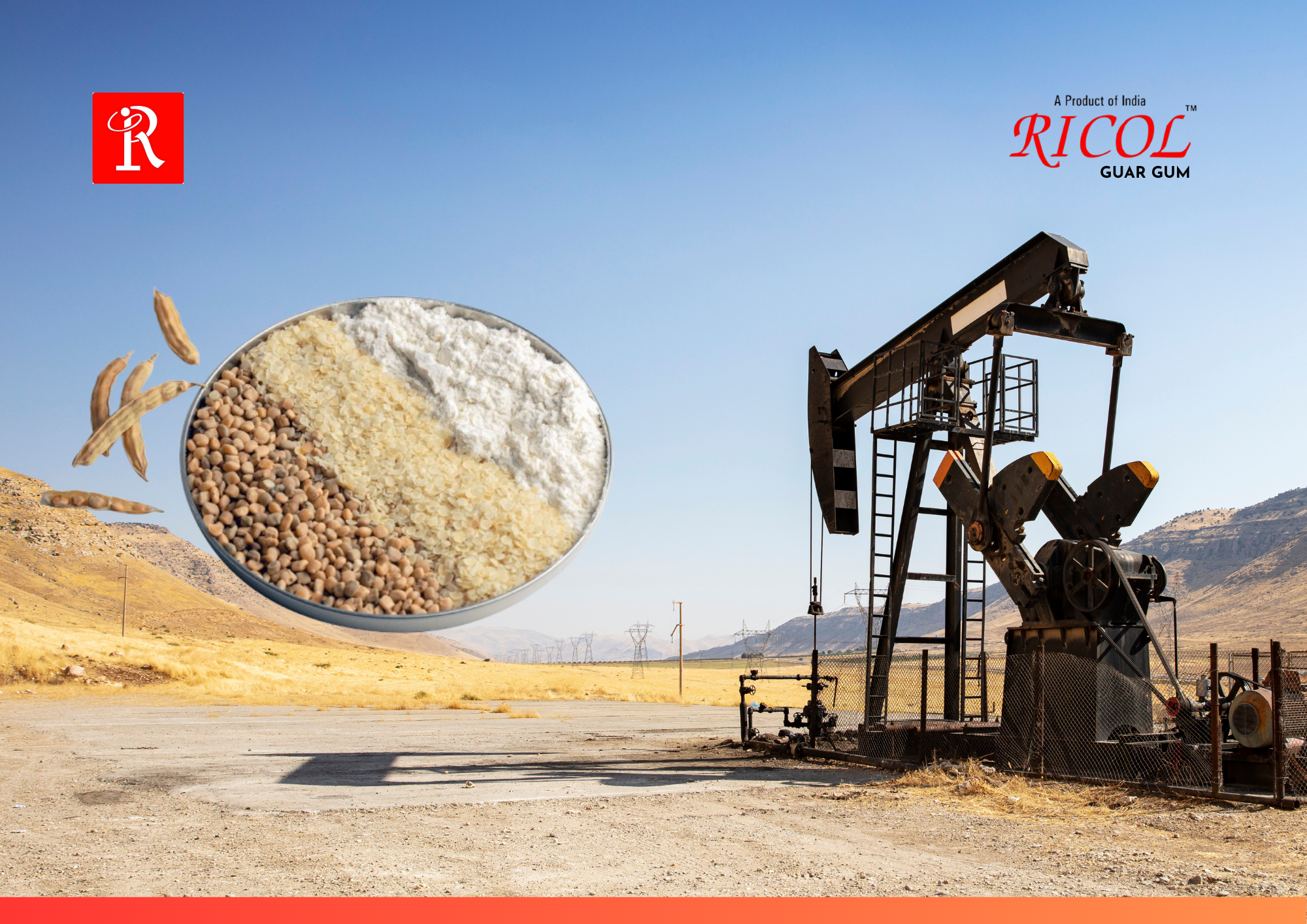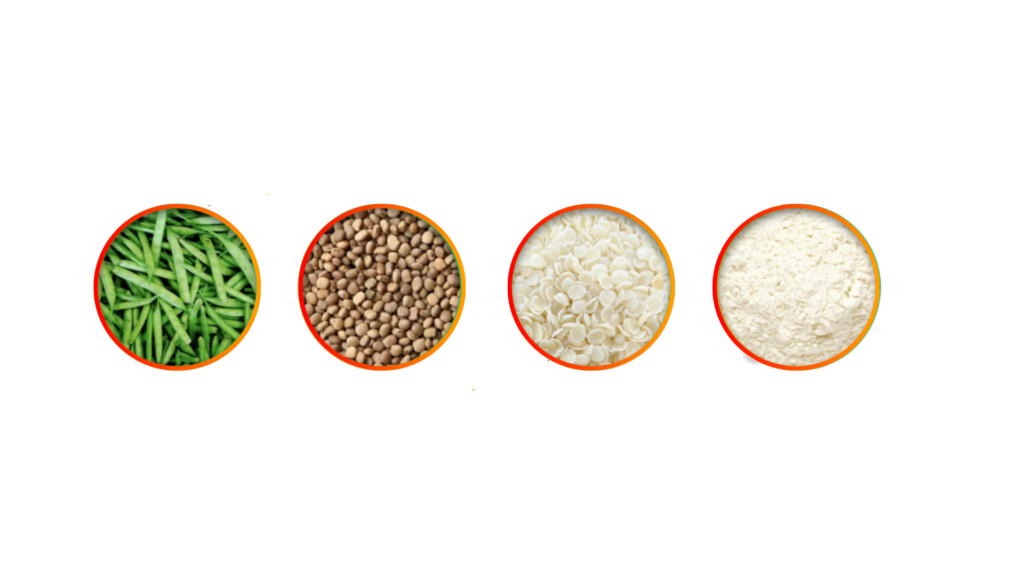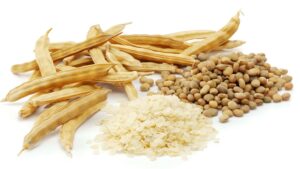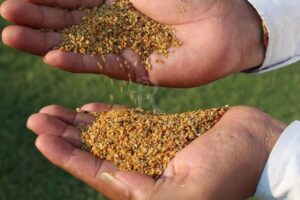
Applications of Guar Gum in the Oil & Gas Industry and How it is used ?
Applications of Ricol® Guar Gum in the Oil & Gas Industry and How to Use It
Guar gum, derived from the seeds of the Cyamopsis tetragonoloba plant, has become an indispensable additive in the oil and gas industry, especially in drilling and hydraulic fracturing operations. Known for its high viscosity, water-solubility, and natural thickening properties, guar gum has found numerous applications that enhance the efficiency, safety, and effectiveness of oil and gas exploration and extraction. In this blog, we’ll explore how guar gum is used in the oil and gas industry, its key applications, and how it benefits the sector.
What is Guar Gum?
Guar gum is a natural polysaccharide made up of galactose and mannose sugars. It’s primarily used as a thickening agent, stabilizer, and emulsifier in a wide range of industries, including food, pharmaceuticals, cosmetics, and more. In the oil and gas industry, guar gum plays a critical role due to its ability to form highly viscous solutions when mixed with water. This property makes it a vital component in oil well drilling and hydraulic fracturing fluids. Rama Gum Industries is one of the largest players involved in guar gum manufacturing and exporting for Oil and gas application.

Key Applications of Ricol® Guar Gum in Oil & Gas Industry
1. Hydraulic Fracturing (Fracking)
Hydraulic fracturing, or fracking, is a process used to extract oil and natural gas from underground rock formations, particularly shale. In this process, a mixture of water, sand, and chemicals is injected into the rock at high pressure to create fractures, allowing oil and gas to flow more freely to the surface.
Role of Guar Gum: Guar gum is used to thicken the fluid (known as fracturing fluid) and enhance its ability to carry sand or proppants into the fractures. The high viscosity of guar gum ensures that the proppants stay suspended in the fluid, preventing them from settling and ensuring that the fractures remain open. Once the fluid has served its purpose, the guar gum is typically broken down or “degraded” using enzymes or other methods.
How to Use: Guar gum is added to water-based fracking fluids in concentrations typically ranging from 0.5% to 2%. The gum is first hydrated in water, where it forms a gel-like solution. Other chemicals, including surfactants and biocides, may be added to complete the formulation before being pumped into the well.
2. Drilling Fluids (Mud)
Drilling fluid, or drilling mud, is essential for the oil and gas drilling process. It serves several purposes, including cooling and lubricating the drill bit, carrying cuttings to the surface, and maintaining pressure in the well.
Role of Guar Gum: Guar gum is often used in water-based drilling fluids to increase viscosity and improve the carrying capacity of the fluid. It helps suspend cuttings, prevent tool wear, and control pressure during drilling operations. Guar gum-based fluids are preferred in shallow water or onshore drilling because they are eco-friendly and biodegradable.
How to Use: Guar gum is typically mixed with water and other additives (such as bentonite or barite) to create a gel-like drilling mud. It is usually mixed in concentrations of 0.5% to 2% by weight. The concentration can be adjusted depending on the desired viscosity and the specific needs of the drilling operation.
3. Wellbore Cleanout and Cementing
Wellbore cleanout involves removing debris and unwanted materials from the wellbore to prepare it for further operations, including cementing.
Role of Guar Gum: Guar gum helps suspend and carry debris to the surface, ensuring that the wellbore remains clean during operations. Additionally, guar gum is used in the cementing process to enhance the viscosity of the cement slurry. This improves the ability of the slurry to stay in place and bond to the rock formation during well completion.
How to Use: For wellbore cleanout, guar gum is mixed into water-based solutions or in combination with other materials such as spacers or wash fluids. In cementing, guar gum is used to adjust the thickness and flow characteristics of the cement slurry, ensuring it remains in position for proper sealing of the well.

4. Enhanced Oil Recovery (EOR)
Enhanced Oil Recovery (EOR) refers to a variety of techniques used to increase the amount of crude oil that can be extracted from an oil field. Guar gum is used in some EOR techniques to improve the mobility of oil, increase sweep efficiency, and enhance the recovery rate.
Role of Guar Gum: Guar gum-based polymers are used to increase the viscosity of water injected into the oil reservoir. By thickening the injection water, the flow of water can be more controlled, allowing for more effective displacement of oil from the reservoir rock.
How to Use: Guar gum is mixed into the water injection fluid at concentrations ranging from 0.1% to 0.5% to achieve the required viscosity for EOR operations. The guar gum can be crosslinked to enhance its stability in high-temperature and high-salinity conditions.
5. Environmental Applications
Guar gum is often used in environmental cleanup operations, such as oil spill control and waste treatment, because it is biodegradable and non-toxic.
Role of Guar Gum: Guar gum can form viscous gels that help in capturing and absorbing oil during an oil spill. It is also used in the treatment of wastewater from drilling and fracking operations to remove contaminants.
How to Use: Guar gum is mixed with water to create a gel or slurry, which can be applied to contaminated areas to absorb oil. The gel can then be easily removed, reducing the environmental impact of the spill. In wastewater treatment, guar gum is used to flocculate (aggregate) suspended solids and facilitate their removal from the water.
Benefits of Using Guar Gum in Oil & Gas
Cost-Effective: Guar gum is an affordable solution for increasing viscosity in fracking fluids, drilling muds, and other applications, providing significant cost savings compared to synthetic alternatives.
Eco-Friendly: Guar gum is a natural, biodegradable substance that reduces the environmental footprint of oil and gas operations, making it an attractive choice for sustainable practices in the industry.
Improved Performance: The high viscosity and water-solubility of guar gum improve the performance of drilling and fracking fluids, increasing the efficiency of operations and reducing downtime.
Customization: Guar gum can be tailored to meet specific needs, such as enhancing the gel strength for more challenging drilling conditions or reducing the polymer’s sensitivity to temperature or salinity in harsh environments.
How to Use Guar Gum in Oil & Gas Operations

Hydration: To activate guar gum, it must be properly hydrated. This is typically done by slowly adding it to a water-based solution while stirring continuously to prevent clumping.
Mixing: For fracking or drilling fluids, mix the guar gum with water and any additional chemicals in a mixer or a mixing tank. It’s crucial to ensure that the guar gum dissolves completely and forms a uniform solution.
Testing Viscosity: After mixing, it’s important to test the viscosity of the fluid to ensure it meets the required specifications for the specific operation. Viscosity meters or rheometers are used for this purpose.
Adjusting Concentration: The concentration of guar gum can be adjusted based on the specific needs of the operation. Typically, concentrations range from 0.5% to 2% for fracking and drilling fluids, but higher concentrations can be used depending on the desired properties.
Breaking the Gel: In some applications, the guar gum gel needs to be broken down after use. This can be done using enzyme-based breakers (such as guar gum-degrading enzymes) or chemicals to return the fluid to a lower viscosity state for easier removal.
Conclusion
Ricol Guar gum plays an essential role in modern oil and gas operations, from hydraulic fracturing to drilling fluids and enhanced oil recovery. Its ability to thicken, stabilize, and enhance fluid properties makes it invaluable for improving operational efficiency and reducing environmental impact. As the oil and gas industry continues to evolve, guar gum will remain a key component in achieving more sustainable and effective extraction methods.
By understanding the benefits and applications of guar gum in the oil and gas sector, companies can optimize their operations and contribute to more eco-friendly practices while improving productivity.









